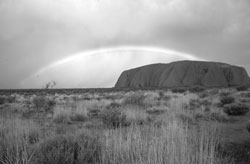Your point of interest
by Janet M. Denninger, a photography tour operator
Back in college I had a photography teacher who harped on one facet of our work: the point of interest. He had a background in photojournalism and felt that a picture taken just for its color or artistic merit was boring and unworthy. I disagreed and continued on my own way with these more “abstract” photographic efforts.
But I had to admit, even then, that he had a good point. Have you ever been subjected to a friend’s vacation slides or album and had to force yourself to murmur, “Hmmm, that’s interesting”? Very often, the picture is attractive but does not capture our imagination or tell us anything about our friend’s experience.
The purpose of this column is to help you find a point of interest. So, each time you raise your camera, ask yourself what it is that attracts you, that makes you want to record the scene. Once you have identified your own “interest,” you will be able to help your audience get the point.
A few illustrations
Okay, so there is Jean, in her lovely yellow sundress, standing by a fountain. What is the “point of interest”? Is it Jean, the dress or the fountain? Chances are, if you are in Rome, and if Jean is not a supermodel, it’s the fountain. So how do you combine these elements and make that picture interesting?
Jean might be smaller than the fountain in the image — and maybe off to one side. Perhaps she could be looking at the fountain, dipping her hand in the water, throwing a coin, sitting on the edge — anything but standing facing the camera smiling, which tends to make her the point of interest. The fountain should be in sharp focus.
In another scenario, I wanted to record a primitive-looking alfombra (flower carpet) in a small village in Guatemala (see picture No. 1). Just taking the record shot was dull, but the small boy watering the flowers to keep them fresh while waiting for the Easter procession gave the arrangement scale and interest. The strong diagonal line makes him the point of interest, and a story is told.
In Burma, I wanted to show some beautiful huge trees, but my efforts were ho-hum. The kids playing in and around the trees (picture No. 2) gave the picture the scale it needed and also told another story, one about childhood in Burma. So, here, my focus and my point became the kids.
In Australia, photographing Ayers Rock is amazing — the desert itself is so beautiful and the rock is spiritual. All my images were showing a fantastic rock with great color, but they were uninspired. Shots of climbers added scale but condoned an activity which is both dangerous and frowned on by the Aboriginal owners of the place. One lucky afternoon, nature provided a rainbow (No. 3) and the spirit was captured on film.
Compositional elements can also help a viewer to hone in on your point of interest, and I will discuss these in another column. In the meantime, you might go through your last vacation pictures and examine each of them for the point of interest.
Viewing your own pictures with an analytical eye will help you become aware of what works for you, and eventually finding the point of interest will become automatic. At the least, when you put together that slide show or album, you will be able to choose the ones with interest and impact.



